The current healthcare system has changed the concept of physical contact with patients; now, digital transformation is taking another form of interaction between medical professionals and their patients. The emergence of patient-centric communication has proven to bridge the divide between healthcare organizations and patients, facilitating appointments, form completion, dates on treatment, and care coordination., These advanced technologies have opened up the possibility of adding luxuries to medical practices; they are the infrastructure to provide efficient and patient-centered care.
Across the globe, healthcare organizations are appreciating the fact that effective communication is directly associated with better patient outcomes, increased scores on the satisfaction scale, and efficient operations. The tools of communication between the patients involve a wide range of digital applications, such as automated appointment reminders and secure messaging systems, to extensive intake management systems and the ability to integrate into telehealth. The COVID-19 pandemic caused an increased rate of adoption, which subsequently compelled the practices to rapidly adopt digital communication strategies capable of sustaining continuity of care and ensuring patient safety.
What Are Patient Communication Tools?
Patient communication tools are an extensive type of digital healthcare application aimed at ensuring smooth communication between healthcare practitioners and their patients. These platforms incorporate a number of communication avenues such as secure messages, automated messages, electronic messages, appointment booking, and sharing of treatment plans.
Modern tools of communicating with patients, in contrast to the traditional methods, which were based on phone calls and writing on paper, utilize cloud-based technology to develop an integrated workflow. They allow healthcare practices to ensure communication with patients that is compliant with HIPAA, at the same time offering convenient and accessible means of communication to their care teams. The features that are part of these solutions usually comprise two-way communications, automatic appointment reminders, electronic intake forms, payments, and real-time notifications regarding treatment plans or test results.
Essential Features to Look for in Patient Communication Software
Considering the tools of communicating with patients that one can implement in their healthcare practice, the most significant factor is the critical capabilities that can enable operational efficiency and patient satisfaction. The right platform should be in a position to easily be integrated with the working practice, as well as provide very powerful features that can be extended with the growth of your practice and changing communication needs.
- HIPAA Compliance: Complete security to give maximum compliance with the federal healthcare privacy requirements, including the end-to-end encryption of the data transmission, secure storage of the data, and complete audit trails to ensure that sensitive medical information is intact at all costs, and yet allow a seamless flow of communication capabilities in all the functions offered on the platform.
- Multi-Channel Integration: The integration of various touchpoints, including SMS messaging, email messages, patient portals, and mobile applications into a single platform in such a manner that patients can choose their channel of communication and, concurrently, create the congruency in sending and receiving messages.
- Automated Workflow Management: Intelligent capabilities, including making repetitive workflows automated, such as appointment notification, follow-up, form distribution, and payment notification, are lessening the workload of the staff and keeping them in constant touch with the patient at any stage of the continuum of care with no manual input.
- Real-Time Analytics: A full-scale reporting dashboard that will give actionable data regarding the communication effectiveness, the rate of patient engagement, response time, and workflow bottlenecks to make data-driven decisions to optimize the practice activities to increase patient satisfaction metrics continuously.
- Fluid EHR interoperability: Organic integration with existing electronic health record systems, which eliminates data silos, automatically combines patient data, involves fewer data entries, and creates the documentation of the history of communication recorded in detailed patient records, which promotes enhanced coordination of care.
Comparison Table for Patient Communication Software
| Tool Name | Rating | Best Feature |
| Phreesia | 4.2/5 | Enterprise-level digital intake management |
| CERTIFY Health | 4.6/5 | Advanced biometric check-in technology |
| Klara | 4.5/5 | No-login patient messaging system |
| SPRY | N/A | Integrated communication with digital intake |
| SimplePractice | 4.7/5 | Mental health specialized platform |
| FormDr | 4.4/5 | HIPAA-compliant form builder |
| Tebra (Kareo) | 4.1/5 | All-in-one practice management solution |
| IntakeQ | 4.3/5 | Unlimited forms at affordable pricing |
| NexHealth | 4.3/5 | Dental and specialty practice optimization |
| Digital Intakes | 4.5/5 | Budget-friendly unlimited submissions |
| Weave | 4.1/5 | Multi-location practice coordination |
List of Top 11 Patient Communication Tools
1. Phreesia
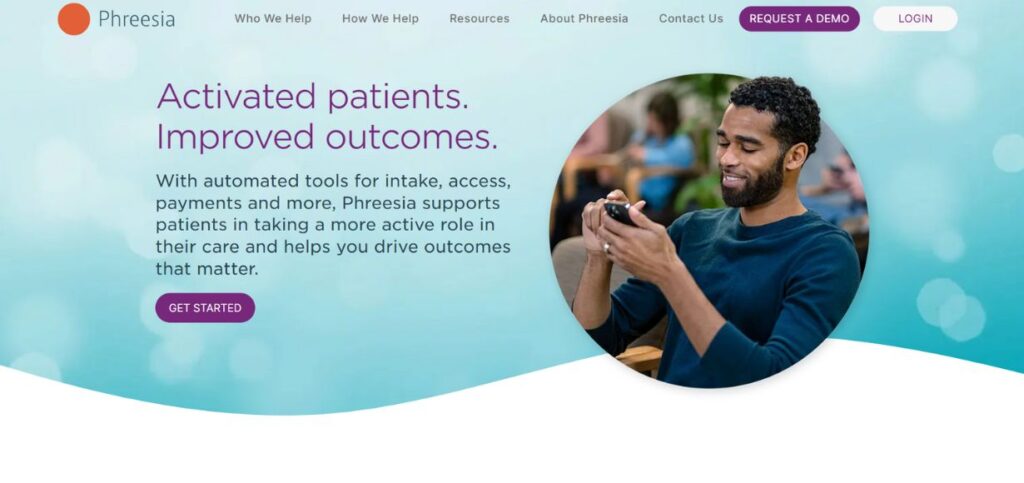
- Rating: 4.2/5
- Website: https://www.phreesia.com/
- Best Use Cases: Large healthcare organizations requiring comprehensive enterprise intake solutions
Phreesia is the patient intake leader in the enterprise category, serving more than 170 million patient visits each year in 4,300+ healthcare facilities. This is a holistic platform that alters the patient arrival experience by enhancing smart digital operations that automate and simplify the process of registration, payment collection, and other clinical screening processes. High-volume operations on the platform are supported by a well-built system infrastructure, and the overall security and compliance standards are high.
The advantage of the system is that it tailors workflows to various medical specialties and offers similar user experiences across all touchpoints. There are the clinical screening capabilities of Phreesia, such as health risk assessment and symptom check-up, which seamlessly integrate into provider workflows. The customization of the brand on the platform enables healthcare organizations to have a uniform branding across the patient journey.
Key Features:
- Complete specialty form library
- Integrated payment processing
- Clinical screening assessments
- Custom branding capabilities
- Real-time eligibility verification
Pros:
- Enterprise-scale reliability
- Comprehensive specialty support
- Advanced payment integration
Cons:
- Complex implementation process
- Higher cost structure
- Steep learning curve
Pricing: Custom pricing
2. CERTIFY Health

- Rating: 4.6/5
- Website: https://www.certifyhealth.com/
- Best Use Cases: High-volume practices seeking innovative digital check-in solutions
CERTIFY Health is the future of patient communication software through its innovative FaceCheck contactless biometric and high-level automation capabilities. This new platform removes the old bottlenecks of check-in by smart pre-registration processes and real-time wait time messages that keep patients informed in the process of visiting the facility.
The multi-language support features of the platform serve to make it suitable for a wide array of patients, whereas the advanced automation ensures that the workload of the staff is considerably lower. Bio-check-in technology available to CERTIFY Health ensures security procedures, yet ensures high-speed patient identification, which accelerates the process of arrival. The wait time notification feature of the system is an SMS based feature that gives real-time updates to the patients, thus enhancing patient satisfaction and decreasing congestion at the lobby.
Key Features:
- FaceCheck biometric technology
- Real-time wait notifications
- Multi-language form support
- Automated pre-registration workflows
- Advanced patient tracking
Pros:
- Innovative biometric features
- Comprehensive automation capabilities
- Multi-language accessibility
Cons:
- Quote-based pricing model
- Technology learning curve
- Implementation complexity
Pricing: Custom pricing
3. Klara
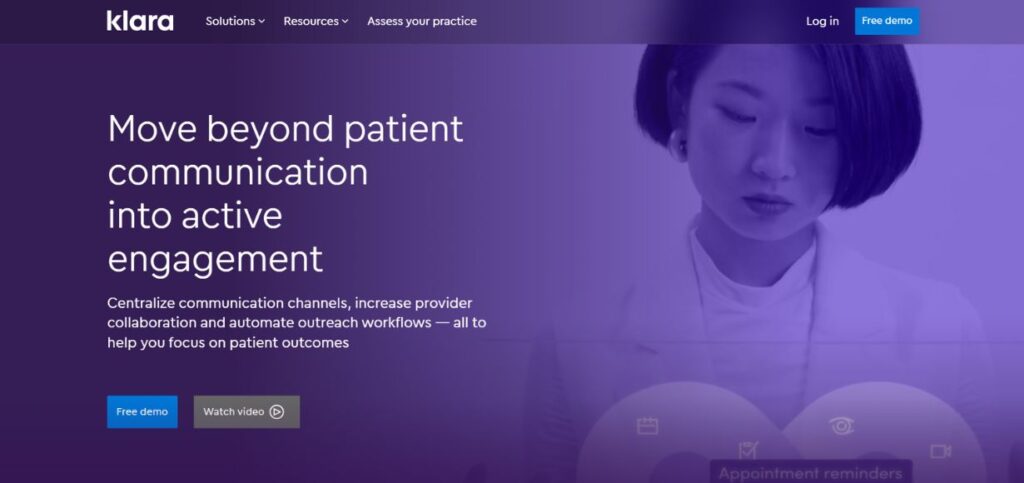
- Rating: 4.5/5
- Website: https://www.klara.com/
- Best Use Cases: Communication-focused practices prioritizing seamless patient messaging experiences
Klara is also on the frontline in transforming the traditional way healthcare is communicated by removing the barriers to interaction with patients with its innovative, unlogged-in messaging system. Patients will be able to communicate with their care teams directly without downloading apps or recalling usernames and passwords to a large extent, which will enhance response rates and overall satisfaction. The system automatically pushes the messages to relevant employees depending on content and urgency, owing to the smart routing features of the platform.
This is a communication-based model that changes the manner in which the practices respond to routine questions, book appointments, and organize follow-up care. The call-to-text conversion tool has been added to Klara to enable the practices to cut down phone calls, whilst still maintaining the personal touch with the patients. The platform encompasses the use of digital forms in the automation of its communication processes and generates smooth patient experiences in the process of first contact and lifelong management of care.
Key Features:
- No-login patient messaging
- Intelligent message routing
- Call-to-text conversion
- Automated form distribution
- Staff workflow optimization
Pros:
- Eliminates login barriers
- Intuitive messaging interface
- Excellent staff routing
Cons:
- Limited form customization
- Monthly location-based pricing
- Basic reporting features
Pricing: Starting at $149/month
4. SPRY

- Rating: Not specified
- Website: https://www.sprypt.com/
- Best Use Cases: Therapy practices needing integrated communication and intake management
SPRY controls the market of therapy practice through flawless integration of patient communication tools and smart digital intake forms that are specifically optimized to fit the occupational therapy, speech-language pathology, and physical therapy practices. The platform also does not use manual intake by removing workflow, automated patient engagement processes that are integrated with scheduling systems and electronic health records.
The smart patient messaging functionality enables the system to send targeted messages to patients about appointments, and the digital integration of intake sends pre-visit forms automatically once the patients have made their appointments. The insurance communication functions of SPRY offer real-time eligibility and authorization forms, which help to ease the load on the administrative functions of practice staff. The care plan sharing feature in the platform allows one to send treatment plans and home exercise programs to patients in a secure way.
Key Features:
- Smart personalized messaging
- Automated intake distribution
- Insurance eligibility notifications
- Care plan sharing
- EHR synchronization
Pros:
- Therapy-specific optimization
- Comprehensive intake automation
- Real-time insurance updates
Cons:
- Limited to therapy specialties
- Custom pricing complexity
- Specialty-specific features only
Pricing: Custom pricing
5. SimplePractice
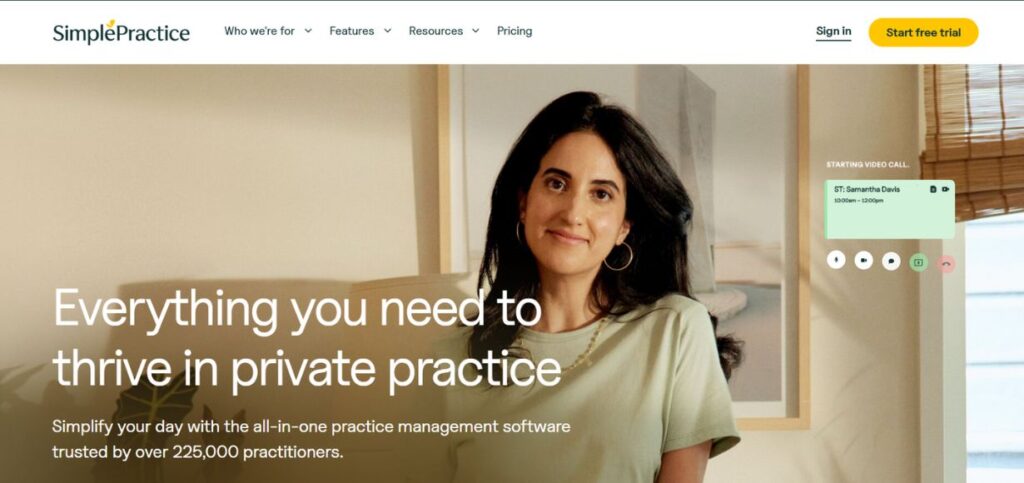
- Rating: 4.7/5
- Website: https://www.simplepractice.com/
- Best Use Cases: Mental health professionals requiring specialized therapy communication platforms
SimplePractice is the market leader in the mental health sector with a set of tools that are specific and specialized to address the patients and that are distinctly defined in therapy practices. The portal provides HIPAA-compliant secure client portals and also convenient access to therapy-specific forms, mental health assessments, and treatment documents. Its telehealth integration capabilities enable it to smoothly connect video sessions with forms to complete before and as follow-up messages.
The system has crisis communication capabilities that include emergency guidelines and safety planning resources, which may be beneficial in guiding mental health professionals to manage emergencies. SimplePractice has a therapy-specific form library that consists of detailed mental health questionnaires and assessment instruments that are directly incorporated into the treatment planning processes. The therapeutic boundaries are secured by the secure messaging aspect of the platform, and there is a convenient way of communication in terms of scheduling an appointment and general inquiries.
Key Features:
- Protected HIPAA-compliant gateway
- Built-in telemedicine system
- Psychology-focused evaluations
- Emergency response communication procedures
- Behavioral health document collection
Pros:
- Psychological care specialization
- Cost-effective fee model
- Outstanding user experience
Cons:
- Restricted to behavioral health
- Elementary automated functions
- Few personalization choices
Pricing: Starting at $14/month
Also Read: Hospital Marketing Agencies in India
6. FormDr

- Rating: 4.4/5
- Website: https://formdr.com/
- Best Use Cases: Security-focused practices requiring robust HIPAA-compliant form solutions
FormDr is also the company that focuses on offering healthcare organizations the safest tools for communicating with their patients, having end-to-end encryption of all data transfers and storage. The conditional logic features allow the platform to produce smart adaptive forms that change questions according to patient answers and are better at increasing completion rates and collecting more applicable clinical data.
The electronic signature capability of the system offers digitally legally binding signatures, which are seamlessly integrated into the clinical operations and documentation demands. The insurance card capture feature of FormDr is based on the mobile photo upload technology to simplify the registration and verification of patients. The strong security architecture of the platform is suitable to support practices that deal with sensitive patient data that needs the most protection.
Key Features:
- End-to-end data encryption
- Conditional logic forms
- Electronic signature capability
- Mobile insurance card capture
- Advanced security protocols
Pros:
- Superior security features
- Adaptive form logic
- Legal signature compliance
Cons:
- Custom pricing model
- Security complexity
- Limited communication features
Pricing: Custom pricing
7. Tebra (Kareo)

- Rating: 4.1/5
- Website: https://www.tebra.com/
- Best Use Cases: Independent practices seeking comprehensive, all-in-one management solutions
Tebra incorporates patient communication tools as part of an integrated practice management platform that includes patient engagement, digital intake processes, and revenue optimization functions. The patient engagement suite in the system sends automated follow-up messages and ensures secure communication, whereas the digital intake workflow comprises electronic forms with embedded insurance checks.
The revenue optimization aspect of the platform includes an in-built billing and payment processing, which automates financial processes along with the interaction with patients. The electronic signature features of Tebra make the digital signature of a patient HIPAA-compliant. This is the all-in-one system that removes the many vendor relationships and offers all the practice management functionality in one integrated system.
Key Features:
- Consolidated practice administration
- Automated patient interaction tools
- Built-in payment processing
- Coverage validation procedures
- Digital signature authorization
Pros:
- Comprehensive practice platform
- Unified financial oversight
- One-stop vendor partnership
Cons:
- Elevated per-clinician expenses
- Intricate functionality suite
- Challenging deployment process
Pricing: Starting at $149/month
8. IntakeQ

- Rating: 4.3/5
- Website: https://forms.intakeq.com/
- Best Use Cases: Small practices requiring unlimited form submissions at budget-friendly pricing
IntakeQ provides a high degree of value to smaller medical care settings since it provides unlimited form creation and submission at extremely competitive rates. The library of templates on the platform is composed of specialized pre-built templates that can be altered to fit various medical disciplines without technical skills. It has tracking services in real time, which provide completion tracking services and automatic reminders.
The system is also entirely cross-device compatible thanks to mobile access, and this guarantees that the patients will be able to complete the forms without any issue with smartphones, tablets, or desktop computers. The IntakeQ flexible form builder enables the attainment of the requirements of different practices and maintains a convenient interface for users and providers. The pricing system of the platform is simple and can thus be affordable to the practices of startups and small healthcare organizations.
Key Features:
- Unrestricted form entries
- Ready-made template collection
- Live completion monitoring
- Complete mobile responsiveness
- Adaptable form personalization
Pros:
- Unlimited submission framework
- Budget-friendly cost structure
- Superior mobile interface
Cons:
- A few sophisticated capabilities
- Elementary messaging functionality
- Restricted connection possibilities
Pricing: Starting at $49/month
9. NexHealth

- Rating: 4.3/5
- Website: https://www.nexhealth.com/
- Best Use Cases: Dental and specialty practices requiring industry-specific communication solutions
NexHealth specializes in serving dental and specialty practices with tailored patient communication tools that address unique scheduling, treatment planning, and patient education needs. The platform’s two-way texting capabilities provide HIPAA-compliant messaging integrated with online booking systems that display real-time availability for complex scheduling requirements.
The system’s automated campaign features enable targeted outreach and recall messaging specifically designed for dental and specialty practice workflows. NexHealth’s form library includes dental and specialty-specific templates that address unique documentation requirements for various medical specialties. The platform’s integration capabilities connect with popular dental practice management systems and specialty EHR platforms.
Key Features:
- Two-way HIPAA messaging
- Automated campaign management
- Real-time scheduling integration
- Specialty-specific form templates
- Practice management integration
Pros:
- Dental specialization focus
- Excellent scheduling integration
- Industry-specific templates
Cons:
- Custom pricing complexity
- Limited general practice features
- Specialty-focused limitations
Pricing: Custom pricing
10. Digital Intakes
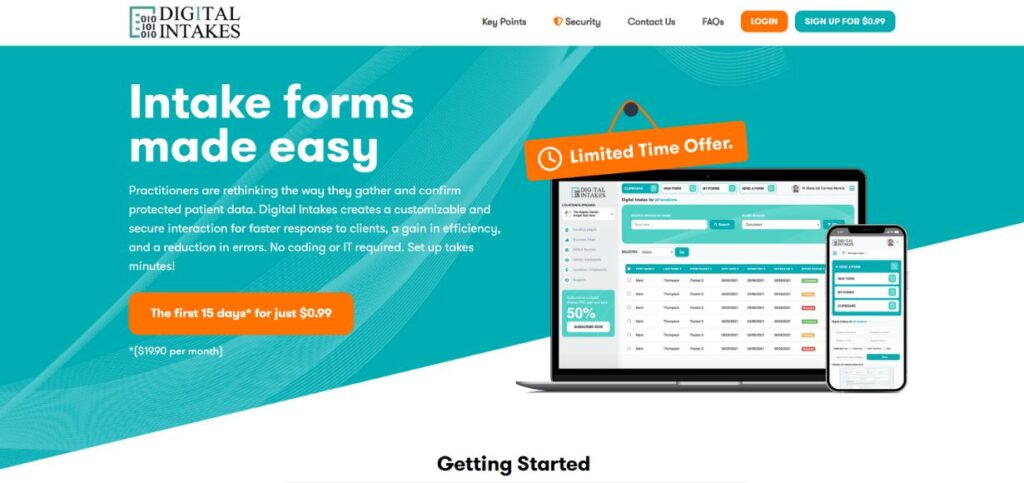
- Rating: 4.5/5
- Website: https://www.digitalintakes.com/
- Best Use Cases: Startups and small practices seeking maximum value digital solutions
Digital Intakes offers healthcare practices with exceptionally good value by offering a robust feature base at very pocket-friendly prices. The no-code builder of the platform allows practices to build advanced forms through easy-to-use drag-and-drop interfaces without the need to have technical knowledge or develop the forms.
The unlimited submission model in the system makes sure that the practices in the system do not receive extra charges as a result of increased patient volumes in the organization, thus making it suitable for growing organizations. The automatic reminder system developed by Digital Intakes consists of both email and SM, which enhances the rates of form completion to a significant point. It has numerous export options, such as PDF and CSV, that can be easily integrated with already existing practice management systems.
Key Features:
- No-code drag-and-drop builder
- Unlimited form submissions
- Automated reminder system
- Multiple export formats
- Budget-friendly pricing
Pros:
- Extremely affordable pricing
- User-friendly interface
- Unlimited submissions included
Cons:
- Limited advanced features
- Basic communication tools
- Minimal integration capabilities
Pricing: Starting at $19.90/month
Also Read: Digital Marketing Agencies for Doctors
11. Weave
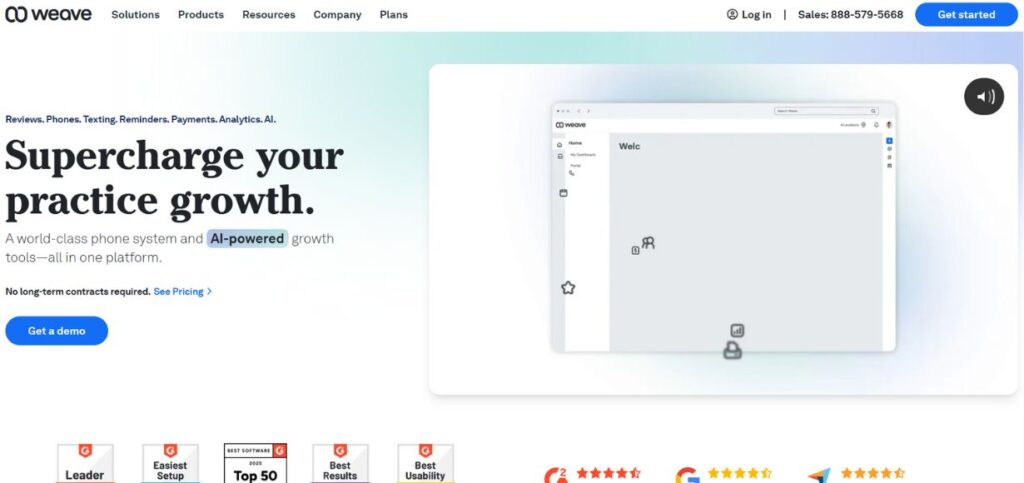
- Rating: 4.1/5
- Website: https://www.getweave.com/
- Best Use Cases: Multi-location practices requiring centralized communication management
Weave has already automated more than 17 million forms using its broad-based communication platform that has integrated phone, text, email, and web chat into a single workflow. The digital forms improvement option on the platform is represented by pre-populated patient data that can save the time spent on the completion process and increase the accuracy rates to a high level.
The payment processing integrated system enables the use of smooth billing services, which interact with patient communication to facilitate smooth revenue cycle management. Multi-location management of Weave provides practice coordination tools, which are centralized, allowing for standardization of communication protocols across office locations. This is why it is especially useful to healthcare organizations in which practice is divided into several markets or clinical locations. Nonverbal patients also have communication tools that are facilitated by visual and text-based interfaces that can support the needs of various patients.
Key Features:
- All-in-one communication platform
- Pre-populated form data
- Integrated payment processing
- Multi-location coordination
- Comprehensive reporting analytics
Pros:
- Complete communication suite
- Multi-location management
- Proven high-volume performance
Cons:
- Quote-based pricing model
- Complex feature set
- Implementation requirements
Pricing: Custom pricing
How to Choose the Right Patient Communication Software
In order to select the most efficient patient communication tools in your healthcare practice, one needs to be mindful of a number of factors that have a direct impact on the efficiency of operations and patient satisfaction. The capabilities of the platform must be aligned to your practice needs, development, and real technology infrastructure when making the decision, so that it can be successful in the long run.
- Specialization: Decide how the platforms are industry-specific, including: pre-built forms, templates, compliance, and integration with specialty-specific EHR systems, which is more efficient in practice and quality of patient care, and with less complexity to implement.
- Scalability: Test the ability of the platform to accommodate the growth of your practice, such as covering multiple locations, addressing user volumes, feature upgrades, and flexible pricing that will be able to sustain increased patient loads without system reassignments and major operations without issues as your organization evolves.
- Integration: Determine how it will be integrated with the existing practice management systems, electronic health record (EHR) systems, billing systems, and scheduling options so that the data can move smoothly through all systems and that there is no duplication of the data entry and workflow breakdown, as well as complete patient records in any system without compromising the functionality.
- Budget: Check the total cost of ownership, subscription cost, implementation cost, training costs, and support costs in the long term, in addition to the assessment of the payback in terms of efficiency improvement, less staff time, patient satisfaction, and improvement of the revenue cycle management.
- Support: Find out the quality of the vendor support by inquiring about the implementation support, ongoing training, willingness to support technical troubleshooting, and willingness to enter into a long-term partnership to meet your goals of successfully adopting the platform and operational excellence during your growth as an organization.
Conclusion
The patient communication technology environment is highly dynamic and is expected to keep on changing swiftly with the rising demands of patients to have convenience and operational efficiency by healthcare organizations. These applications are no longer mere messaging systems but full-fledged patient engagement ecosystems that combine communication and intake, payment processing, and clinical workflows with a seamless and complete system. The effective introduction of patient communication tools between patients should be thoroughly oriented at practice-related requirements, demographic characteristics of patients, the presence or absence of technology infrastructure, and future growth plans.
The future of healthcare communication is the ability to adjust to evolving preferences of patients and still provide the highest levels of security and compliance. With further development of artificial intelligence and machine learning capabilities, patient communications tools will be even smarter and predictive, personalized, and automated in providing workflow optimization, patient experience, and provider efficiency.
Frequently Asked Questions:
Q: What are the Most Significant Features to Consider in Patient Communication Software?
A: Key characteristics are HIPAA compliance, multi-channel integration, automated workflows, real-time analytics, and an integrated EHR to make sure that communication management is comprehensive.
Q: What is the Effect of Patient Communication Software on Practice Efficiency?
A: They also use these platforms to automate simple practices such as appointment reminders, distribution of forms, and follow-ups, and relieve staff of workload without decreasing patient engagement and satisfaction rates.
Q: Are Patient Communication Tools Applicable in Small Practices?
A: Indeed, several platforms have scalable prices and offer features that are optimized to serve smaller practices, with basic functionality starting as low as $19.90/month.
Q: What Guarantees the Security of Patient Data by these Tools?
A: Most popular sites offer end-to-end encryption, HIPAA-qualified messages, secure storage of data, detailed audit projections, and frequent security patches to secure confidential patient data.
Q: Will Patient Communication Tools Interface with the Current EHR Systems?
A: The majority of contemporary platforms are native EHR-integrated and automatically match patient records across all systems, preventing the duplication of personal data entry and providing a complete system record-keeping.






